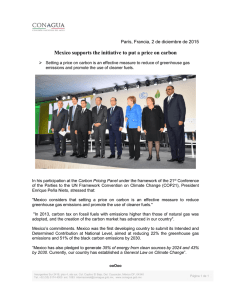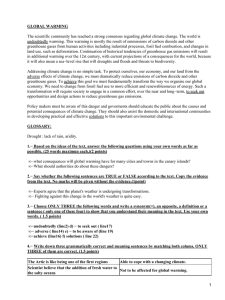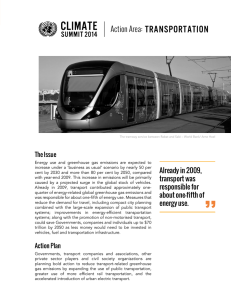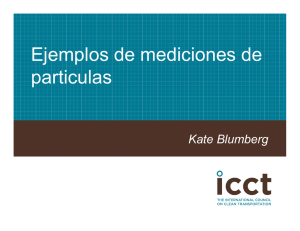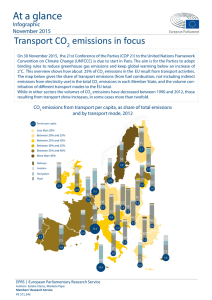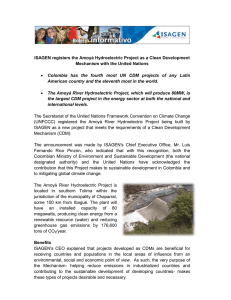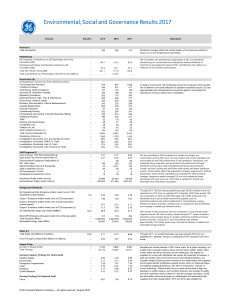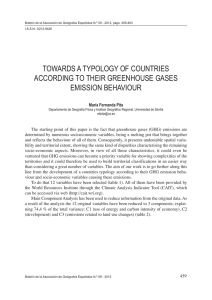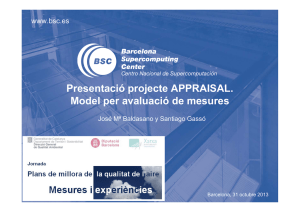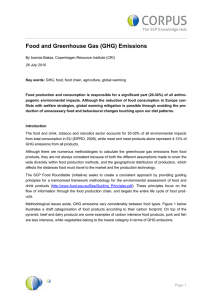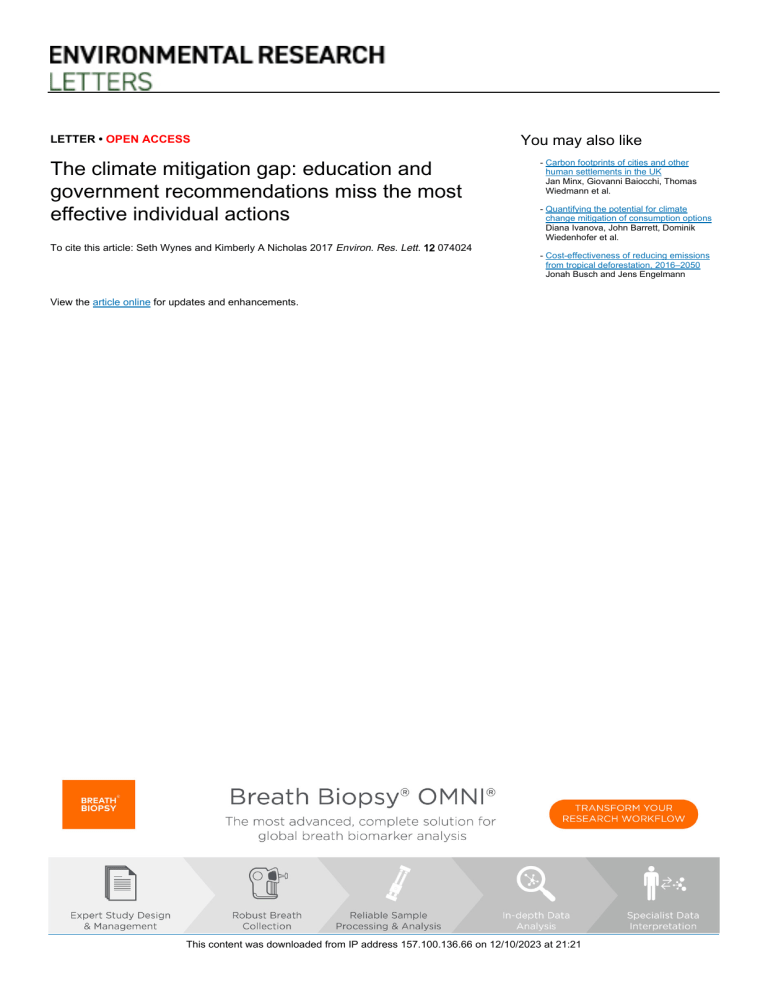
LETTER • OPEN ACCESS The climate mitigation gap: education and government recommendations miss the most effective individual actions To cite this article: Seth Wynes and Kimberly A Nicholas 2017 Environ. Res. Lett. 12 074024 You may also like - Carbon footprints of cities and other human settlements in the UK Jan Minx, Giovanni Baiocchi, Thomas Wiedmann et al. - Quantifying the potential for climate change mitigation of consumption options Diana Ivanova, John Barrett, Dominik Wiedenhofer et al. - Cost-effectiveness of reducing emissions from tropical deforestation, 2016–2050 Jonah Busch and Jens Engelmann View the article online for updates and enhancements. This content was downloaded from IP address 157.100.136.66 on 12/10/2023 at 21:21 Environ. Res. Lett. 12 (2017) 074024 https://doi.org/10.1088/1748-9326/aa7541 LETTER OPEN ACCESS The climate mitigation gap: education and government recommendations miss the most effective individual actions RECEIVED 5 January 2017 Seth Wynes1,2,3 and Kimberly A Nicholas1 REVISED 1 24 May 2017 2 ACCEPTED FOR PUBLICATION 26 May 2017 PUBLISHED 12 July 2017 3 Lund University, Centre for Sustainability Studies, PO Box 170, Lund SE-221 00, Sweden University of British Columbia, The Department of Geography, Vancouver Campus, 1984 West Mall, Vancouver, BC, V6T 1Z2, Canada Author to whom any correspondence should be addressed. E-mail: [email protected] Keywords: climate change mitigation, environmental behaviour, education, climate policy, transformation pathways Original content from this work may be used under the terms of the Creative Commons Attribution 3.0 licence. Any further distribution of this work must maintain attribution to the author(s) and the title of the work, journal citation and DOI. Supplementary material for this article is available online Abstract Current anthropogenic climate change is the result of greenhouse gas accumulation in the atmosphere, which records the aggregation of billions of individual decisions. Here we consider a broad range of individual lifestyle choices and calculate their potential to reduce greenhouse gas emissions in developed countries, based on 148 scenarios from 39 sources. We recommend four widely applicable high-impact (i.e. low emissions) actions with the potential to contribute to systemic change and substantially reduce annual personal emissions: having one fewer child (an average for developed countries of 58.6 tonnes CO2-equivalent (tCO2e) emission reductions per year), living car-free (2.4 tCO2e saved per year), avoiding airplane travel (1.6 tCO2e saved per roundtrip transatlantic flight) and eating a plant-based diet (0.8 tCO2e saved per year). These actions have much greater potential to reduce emissions than commonly promoted strategies like comprehensive recycling (four times less effective than a plant-based diet) or changing household lightbulbs (eight times less). Though adolescents poised to establish lifelong patterns are an important target group for promoting high-impact actions, we find that ten high school science textbooks from Canada largely fail to mention these actions (they account for 4% of their recommended actions), instead focusing on incremental changes with much smaller potential emissions reductions. Government resources on climate change from the EU, USA, Canada, and Australia also focus recommendations on lower-impact actions. We conclude that there are opportunities to improve existing educational and communication structures to promote the most effective emission-reduction strategies and close this mitigation gap. 1. Introduction While 195 nations have agreed to limit the global average temperature increase to ‘well below 2 °C’ under the December 2015 Paris Agreement (UNFCCC 2015), most current pathways to stay under the 2 °C limit assume the future use of unproven technologies to achieve negative emissions (Fuss et al 2014). This has prompted calls (Anderson 2015) for near-term, profound emissions cuts that may require changes in lifestyle choices from the high-carbon individuals estimated to produce nearly 50% of emissions (Gore 2015). National policies and major energy transformations often take decades to change locked-in © 2017 IOP Publishing Ltd infrastructure and institutions, but behavioural shifts have the potential to be more rapid and widespread (i.e. reduced reliance on cars can begin immediately, whereas improved power plant efficiency occurs on a decadal time frame (Pacala and Socolow 2004)). It is especially important that adolescents are prepared for this shift. They still have the freedom to make large behavioural choices that will structure the rest of their lives, and must grow up accustomed to a lifestyle that approaches the 2.1 tonnes per person annual emissions budget necessary by 2050 to meet the 2 °C climate target (Girod et al 2014). Furthermore, adolescents can act as a catalyst to change their household’s behaviour (Maddox et al 2011). While the Environ. Res. Lett. 12 (2017) 074024 cumulative emissions impact of any behaviour depends both on the magnitude of the action and its behavioural plasticity (the proportion of the public likely to adopt a given action assuming the most effective intervention (Dietz et al 2009)), the first step to understanding cumulative impact is to know the effectiveness of the action for a single person. Here we investigate a comprehensive suite of lifestyle choices to identify those with the greatest potential to reduce individual greenhouse gas emissions. We compare our findings with recommendations from high school science textbooks and government resources. Previous studies have already evaluated some of the most effective actions for reducing energy consumption (Attari et al 2010, Gardner and Stern, 2008) and mitigating climate change through personal actions (Girod et al 2014), though individuals have a poor understanding of which actions are more effective than others (Attari et al 2010). Our research builds on these studies by including additional actions that have greater emissions reduction potential but have not been previously evaluated. Our methodology makes each action comparable for individuals making the decision to undertake them, and our analysis of official educational and government materials shows the extent to which public institutions currently recognize the importance of and encourage these behaviours. 2. Methods 2.1. High-impact actions To identify our high-impact actions, we analyzed the literature to compile a candidate list of actions for emissions analysis. To choose data sources, we first used peer-reviewed literature with a life-cycle approach where available (to analyze the impact of diet and personal vehicles), followed by government reports, grey literature or carbon calculators (green energy, aviation). We analyzed studies from all countries we could find, but in the main text only report results from developed nations (the full range of studies are available in the online supplementary materials available at stacks.iop.org/ERL/12/074024/ mmedia). The choice to focus on developed regions was motivated by the higher emission and consumption levels in those regions, which demand steeper emissions cuts in order to attain the same, low per capita emissions target that will avoid dangerous planetary warming (Girod et al 2013). For calculations, all actions were framed in such a way that they would take the maximum possible effect. For instance, recycling is framed as recycling comprehensively for a year, a plant-based diet is framed as avoiding all meat, and purchasing renewable energy is framed as purchasing all possible household energy from renewable sources for a year, even though it would be possible to perform these actions as half-measures. 2 Since the unit of analysis was the individual, we wanted country-specific data to inform the most relevant individual choices possible. Therefore, household and vehicular actions were divided by the average household or vehicle occupancy of the country where the study was performed to yield results measured in tonnes of CO2-equivalent per year (tCO2e per year) per individual. The types of greenhouse gases included in these calculations varied with the methodologies of the different studies or sources. We also made calculations using country or region-specific data, such as average annual kilometers travelled per vehicle in a region (except where study parameters explicitly stated alternative values), to generate final values that are representative for each study area (see supplementary materials 1). For the action ‘have one fewer child,’ we relied on a study which quantified future emissions of descendants based on historical rates, based on heredity (Murtaugh and Schlax 2009). In this approach, half of a child’s emissions are assigned to each parent, as well as one quarter of that child’s offspring (the grandchildren) and so forth. This is consistent with our use of research employing the fullest possible life cycle approach in order to capture the magnitude of emissions decisions. In the case of aviation, some carbon calculators made use of a radiative forcing index, which accounts for the additional warming effects of gases other than CO2 produced during air travel. Though this results in higher estimates than if the index had not been used, the life cycle studies which we also included for aviation (and which did not use radiative forcing) provided similar final values. See supplementary materials 2 for calculations. In practice, the emissions benefits of undertaking high-impact actions may be reduced by substitution effects (where avoidance of emissions from one action is replaced by emissions from another action) and rebound effects (where reduced consumption in one area leads to increased consumption elsewhere). For instance, the emissions saved from living car-free may be lower than we calculated if public transit replaces car travel instead of biking or walking (living car free represents all the emissions associated with the life cycle of owning a car in our methodology). But even if the number of kilometers travelled remains constant, a switch from driving a sedan to taking public transit has been shown to reduce emissions by 26%–76% (Chester et al 2013). Since data that included rebound effects were only available for some actions, we excluded rebound effects to maintain comparability between actions. 2.2. Textbook analysis Textbooks are a useful indicator of the content that students are receiving in classrooms; they are based on government-mandated curriculum documents and serve as a resource for both students and teachers. This may be especially true for subjects such as climate Environ. Res. Lett. 12 (2017) 074024 change where a teacher is more likely to be uncomfortable with the material (Kim and Fortner 2006, Chambers 2011). Ten textbooks used in seven of Canada’s ten provinces were therefore analyzed (see supplementary materials 3). To determine which science textbooks are in use in each province we relied on the experience of the first author as a secondary school science teacher in Canada, and also contacted curriculum writers and educators from provinces where textbook usage could not be easily determined. The provinces covered by our analysis represent more than 80% of Canada’s student population (we were unable to obtain the textbooks used by the provinces of Alberta, Manitoba, and Nova Scotia). Only the textbook chapters directly addressing climate change were analyzed. Statements from the textbooks were identified as suggested actions when they included direct recommendations (e.g. ‘eat less meat’), or were directed at the reader using pronouns such as ‘you’ or ‘we’. Statements using ‘individuals’ and ‘consumers’ often explained sources of emissions without suggesting how to reduce those emissions, and were therefore not counted. Due to the large number of unique recommendations found in textbooks, we grouped similar specific recommendations into various categories. For example, suggestions such as ‘use cloth shopping bags’ and ‘purchase a reusable water bottle’ would both be listed under the category ‘reuse’. Where possible, these categories are the same in the analysis of textbooks and government documents. For each textbook, we recorded the frequency of each type of suggestion. In our coding system, a single sentence referring to a specific topic was given the same value as a paragraph devoted to a single topic. If a paragraph on a broad topic (e.g. household heating) included many specific suggestions (turn down thermostat, purchase a more efficient heater), then each specific suggestion was counted towards the total. 2.3. Government documents To analyze broad societal mitigation recommendations, we chose three developed regions with high percapita emissions and government documents available in English: Australia (average per-capita emissions of 16.3 tCO2 per year), Canada (13.5 tCO2 per year), and the United States (16.4 tCO2 per year), as well as a lower-emission case, the European Union (6.7 tCO2 per year) (World Bank 2016). We identified the most authoritative and relevant set of recommendations from that region indicating how their citizens can help mitigate climate change, contacting government representatives for clarification where multiple possible documents were found. The frequency of individual recommendations was recorded using the same methods as described in the analysis of science textbooks. 3 3. Results From analyzing 148 scenarios of the climate impact of individual behaviours in ten individual countries (with some studies additionally considering the whole EU region), drawn from 39 sources, we have identified a dozen actions, including four recommended actions that are of substantial magnitude throughout the developed world (see supplementary materials 4): having one fewer child, living car free, avoiding air travel, and eating a plant-based diet (figure 1). Each of these actions was high-impact (reduces an individual’s greenhouse gas emissions by at least 0.8 tCO2e per year, about 5% of current annual emissions in the US or Australia) regardless of study parameters. They are also ‘best in class’—most fully achieving emissions reductions within a given domain (e.g. car travel), and with the potential to contribute to systemic change (for example, living car-free reduces the need to build more roads and parking spaces, and supports higher-density urban design, which more efficient cars do not). We originally hypothesized that two additional actions, not owning a dog and purchasing green energy, would also fit our criteria for recommended high-impact actions, but found both to be of questionable merit. Only two studies with conflicting results could be found for dog ownership (Eady et al 2011, Rushforth and Moreau 2013), so we have not included it in figure 1 (see supplementary materials 2). For green energy, researchers have described problems with double-counting in several European countries (Hast et al 2015), as seen in the near-zero emission reductions for Great Britain in figure 1. Still, in regions with carbon-based energy grids such as Australia and North America, green energy has the potential to greatly reduce emissions associated with home energy use, which is why we retained this action in figure 1. Previous studies that compare the effectiveness of various actions tend to focus on moderate-impact actions (saving between 0.2 and 0.8 tCO2e year) or even low-impact actions (saving <0.2 tCO2e). Compare for instance two actions cited as among the most effective ways to reduce household energy usage (hang drying clothing (0.21 tCO2e) and washing clothing in cold water (0.25 tCO2e) (Attari et al 2010)) with any of the high-impact actions shown in green (figure 1). Our recommended highimpact actions are more effective than many more commonly discussed options (e.g. eating a plantbased diet saves eight times more emissions than upgrading light bulbs). More significantly, a US family who chooses to have one fewer child would provide the same level of emissions reductions as 684 teenagers who choose to adopt comprehensive recycling for the rest of their lives. To illustrate the implications of our findings, consider that per capita emissions must reach 2.1 tCO2e by 2050, if warming of the planet is to be kept below 2 °C (Girod et al 2013). Using values from Emissions savings (tCO2e per year) Environ. Res. Lett. 12 (2017) 074024 120 100 80 60 40 20 4 USA RUS JPN USA 3 AUS AUS CAN 2 USA CAN BEL EU AUS GBR USA USA 1 GBR EU BEL 0 NZL USA,GBR DEU NLD GBR Have one fewer child Live car Avoid one Buy green Buy more Switch Plant-based Replace Recycle Wash free transatlantic energy efficient electric car diet gasoline clothes in flight car to car free with hybrid cold water High-Impact (>0.8 tCO2e) Moderate-Impact (0.2-0.8 tCO2e) Low-Impact (<0.2 tCO2e) Hang dry Upgrade clothes light bulbs Mean regional value Figure 1. A comparison of the emissions reductions from various individual actions. The height of the bar represents the mean of all studies identified in developed nations, while black lines indicate mean values for selected countries or regions (identified by ISO codes) where data were available from specific studies. We have classified actions as high (green), moderate (blue), and low (yellow) impact in terms of greenhouse gas emissions reductions. Note the break in the y-axis. See supplementary materials 5 for details. figure 1, we estimate that an individual who eats meat and takes one roundtrip, transatlantic flight per year emits 2.4 tCO2e through these actions, exhausting their personal carbon budget, without accounting for any other emissions. It would help meet climate goals if such an individual chose to shift her or his behaviour, as technological advances may be unable to sufficiently reduce emissions from these two actions even by 2050 (Girod et al 2013). These two sectors are an agreed area of focus for reduced demand, as aviation is likely to be the last of all transport modes to mainstream low-carbon standards (Kivits et al 2010) and studies show we cannot expect to stay under a 2 °C limit without at least some shifts in diet (Hedenus et al 2014). These results also highlight the greater reductions available from moving away from a polluting technology (living car-free, 2.4 tCO2e per year lower than the baseline of a gasoline automobile) compared with using the cleanest available technology (electric cars, which still emit 1.15 tCO2e per year on average) or incremental technological improvements (increase vehicle fuel economy by buying a more efficient gasoline car, 1.19 tCO2e saved per year). Though electric cars may replace internal combustion vehicles and shrink the carbon footprint of the automobile, the car-based transport model itself still allows for low-density rural housing developments (Muller 2004), which are associated with twice the emissions per capita of high-density housing (Norman et al 2006) as well as greater consumption and energy use (Ala-Mantila et al 2014, Shammin et al 2010). A car-free lifestyle reduces traffic congestion and petroleum dependence 4 (Mashayekh et al 2012) and avoids the environmental toxicity issues surrounding electric vehicle production (Hawkins et al 2013), making it advantageous even in an era of low-emission vehicles. Lastly, until the emissions associated with desired services are reduced to zero, population will continue to be a multiplier of emissions (Waggoner and Ausubel 2002). Having identified which actions are high or lowimpact, it is worthwhile to know whether governments and educators are emphasizing high-impact actions. Since we consider adolescents an ideal demographic to adopt high-impact actions, we analyzed ten Canadian high school science textbooks (see supplementary materials 3) to find which broad categories as well as specific actions are currently recommended to adolescents for reducing emissions. We found that the 216 individual recommended actions from textbooks overwhelmingly focused on moderate or low-impact actions, with our recommended actions mostly presented in a less effective form, or not at all (only eight mentions, or 4%). No textbook suggested having fewer children as a way to reduce emissions, and only two out of ten mentioned avoiding air travel (figure 2). Eating a plant-based diet was presented in the form of moderate-impact actions such as eating less meat, even though a completely plant-based diet can be 2 to 4.7 times more effective at reducing greenhouse gas emissions than decreased meat intake (Meier and Christen 2012). Similarly, methods for reducing one’s impact while driving were mentioned almost 30 times, with only six mentions of a car-free lifestyle. Instead, the recommendation category mentioned in the most textbooks was Environ. Res. Lett. 12 (2017) 074024 Have one fewer child Live car free Avoid air travel Reduce effects of driving Buy green energy Eat a plant-based diet Home heating/cooling efficiency Install solar panels/renewables Use public transportation, bike, walk Buy energy efficient products Conserve energy Eat less meat Reduce consumption Reuse Recycle Eat local Conserve water Minimize waste, buy less packaging Plant a tree Compost Purchase carbon offsets Reduce lawn mowing Eliminate unnecessary travel Buy organic food Vote Letter to company/elected official Petition Spread awareness Join organization 0 5 2 6 0 0 6 1 5 4 6 2 4 5 7 4 6 4 3 3 4 1 1 2 1 4 1 5 5 0 10 20 30 40 Number of mentions in ten high school textbooks High-Impact Moderate-Impact Low-Impact Civic Figure 2. An analysis of individual actions recommended for mitigating climate change in ten Canadian high school science textbooks. The number of unique textbooks making each recommendation is shown at the end of each bar. Recommendations are approximately ranked from most effective at reducing greenhouse gas emissions at the top to least effective at the bottom, following data in figure 1 (we have not quantified the emissions reductions from civic actions). Recommended actions (based on emissions savings in figure 1) are in bold. See supplementary materials 3 for full breakdown and list of textbooks. recycling (seven of ten textbooks) and the recommendation category with the most individual actions mentioned was energy conservation (32 mentions) (figure 2). This trend of focusing on lower-impact actions is generalizable in other developed countries. We analyzed four government guides, each selected as an authoritative source for its region and found a focus on moderate-impact actions such as recycling or reducing home energy use (table 1). Except for a handful of references to the quantity of emissions saved by specific actions (altogether missing from the Canadian guide), these guides provided little information for users to discern which actions might be more effective, and therefore which to prioritize. Regarding our identified high-impact actions, no guide recommended having fewer children or eating a plant-based diet, though the EU guide did suggest eating less meat and more vegetables. Neither the US nor Australian guides suggested avoiding air travel. All government guides discussed reducing the impact of personal vehicles through buying cleaner cars or driving or maintaining them better, and all suggested increased use of cycling or public transport, but only Australia adopted the framing of a car-free lifestyle. 5 4. Discussion While past research has focused on incremental behavioural changes that require minimal effort on the part of individuals (Dietz et al 2009), we propose to empower individuals to focus on changing the behaviours that are most effective at reducing their personal emissions. Many of these changes can be seen as desirable choices that promote a slower and healthier lifestyle (Soret et al 2014, Frank et al 2004). In addition to adolescents, it would also be beneficial for those who are already willing to make impactful lifestyle changes for the sake of the climate to be aware of which actions will be most effective. Serious behavioural change is possible; there is evidence that younger generations are willing to depart from current lifestyles in environmentally relevant ways. For instance, the United States has seen as a measurable decrease (Kuhnimhof et al 2013) or at the very least, delay in car usage and ownership for the millennial generation compared to previous generations (Garikapati et al 2016). In terms of plant-based diets, the willingness of individuals to eat less meat increases with the perceived effectiveness of this action, which suggests the need for increased Environ. Res. Lett. 12 (2017) 074024 Table 1. Actions recommended in government documents to reduce an individual’s greenhouse gas emissions. CO2 reductions are based on sources from figure 1 (see supplementary materials 4), unless otherwise noted. Our recommended high impact actions are shown in bold. Results are from four government sources: ‘Take Action’ from Australia (Department of Industry and Science 2014), ‘Top 10 Things You Can Do To Help’ from Canada (Government of Canada 2012), ‘Climate Action’ from the European Union (European Commission, 2015) and ‘What You Can Do’ from the United States (EPA 2015). Behaviour Approximate CO2e reduced per year (kg) Example AUS CAN USA EU High Impact Actions Have one fewer child Live car free Avoid one flight (depending on length) Purchase green energy Reduce effects of driving Eat a plant-based diet 23 700–117 700 1000–5300 700–2800 Buy more efficient car x x x <100–2500 1190 300–1600 x x x x x x x x 180 (Chitnis et al 2013) x x x x x x x x x x x x x x x x x x x x x x x x x x x x Moderate Impact Actions Home heating/cooling efficiency Install solar panels/renewables Use public transportation, bike, walk Buy energy efficient products Conserve energy Reduce food waste Eat less meat Reduce consumption Reuse Recycle Eat local Wall insulation Rooftop solar Energy Star Hang dry clothes No food waste 210 370 (Hoolohan et al 2013) 230 (Meier and Christen 2012) Pay bills online Reusable shopping bag 5 (Dickinson et al 2009) 210 0–360 (Coley et al 2009, Weber and Matthews 2008) x x x x x x Low Impact Actions Conserve water Eliminate unnecessary travel Minimize waste Plant a tree Compost Purchase carbon offsets Reduce lawn mowing Ecotourism Run full dishwasher x x x 6–60 (Freedman and Keith 1996) x x x x x x x Let lawn grow longer Use Ecolabelled accommodation Keep backyard chickens Buy Ecolabel products Calculate your home’s footprint x x x x x x x x x Civic Actions Spread awareness Influence employer’s actions Influence school’s actions x x x awareness of the most effective options for sustainable dietary changes (De Boer et al 2016). However, even knowledgeable and willing individuals may not reduce meat intake or adopt other high impact actions if cultural norms or structural barriers act as obstacles. For example, western cultural norms associate meat with wealth, status and luxury (Ruby 2012) and meat consumption per capita in the richest 15 nations is 750% higher than in the poorest 24 nations (Tilman and Clark 2014). Just as cultural norms promote meat consumption, structural choices such as sprawling neighbourhoods can promote individuals’ use of high carbon transport (Cervero 2002). Shifts in public policy, such as a carbon tax on 6 x food commodities (Springmann et al 2016) or encouraging compact urban growth (Hankey and Marshall 2010), can address these barriers. The benefits of such policies extend beyond climate change; plant-based diets conserve biodiversity and reduce illnesses like cancer and type II diabetes (Tilman and Clark 2014) while car-free living can reduce obesity (She et al 2017) and airborne pollutants (Chester et al 2013). Though we have analyzed the transmission of information, we do not intend to endorse the widely criticized knowledge deficit model of behaviour (Kahan et al 2012), which holds that people will act to prevent climate change if they understand it better. Environ. Res. Lett. 12 (2017) 074024 Tested strategies for promoting individual actions to mitigate climate change have been explored elsewhere, such as showing students how to use public transit, rather than simply encouraging it (Cornelius et al 2014). But before these strategies can be widely implemented in classrooms, there must be accurate information to prioritize actions in curriculum documents and teaching materials such as textbooks. Some high-impact actions may be politically unpopular, but this does not justify a focus on moderate or low-impact actions at the expense of high-impact actions. As a specific example, one textbook says ‘making a difference doesn’t have to be difficult’ and provides the example of switching from plastic bags to reusable shopping bags in order to save 5kg of CO2 per year (Dickinson et al 2009). This is less than 1% as effective as a year without eating meat. Examples like this create the impression that the issue of climate change itself is trivial in nature, and represent missed opportunities to encourage serious engagement on high-impact actions. It is possible that textbook and government writers intentionally selected low-impact actions because they are frequent and easy to perform. If so, this would likely follow the ‘foot-in-the-door technique’, a type of positive spillover where encouraging small actions is hoped to lead individuals to take more substantial behaviours later (Thøgersen and Crompton 2009). Unfortunately, empirical evidence of the spillover effect is mixed. Some interventions result in an increase in other pro-environmental behaviours but most examples of positive spillover occur between similar actions, i.e. not from small actions to substantial ones (Truelove et al 2014). Early results also indicate that high-commitment, pro-social behaviours are more likely to cause further positive spillover (Gneezy et al 2012), which supports an emphasis on high-impact actions as a way to change overall norms. Regardless of spillover effects, some actions will doubtless have a reduced cumulative emissions impact because barriers currently limit their uptake on a large scale. But the inclusion of such actions in textbooks demonstrates the seriousness of climate change, and offers a starting point for important discussions that challenge unsustainable societal norms. Whether the goal is to slowly change societal norms or to encourage significant personal emissions reductions, adolescence is an ideal time for intervention. The majority of the textbooks that we analyzed are aimed at Grade 10 students (typically age 16), which is the same age that most Canadians are first allowed to obtain a driver’s license (Government of Canada 2014). Adolescents can also choose their own diets, can influence family decisions on vacations (e.g. flying vs. staying local) and should be informed of the environmental consequences of family size as they are likely becoming sexually active. Though a 50-year-old 7 car owner with an established lifestyle living in the suburbs might be better able to adopt a recommendation to drive a more efficient car, there are qualitative (paradigm shifting of social norms) and quantitative (emissions reduction) reasons for an adolescent to instead receive the high-impact message: ‘live car free’. It is important to acknowledge the limitations and uncertainty of the data that we have presented. We provide mean values for our recommended actions, but we do not suggest that these are firm figures universally representative of each action, but instead best estimates. For instance, a transatlantic flight will differ in emissions magnitude based on the exact distance travelled, weight of a passenger’s luggage, the occupancy of the plane, wind speed and many other variables, in addition to the differences inherent in varying assessment methodologies. Our estimations are most useful when they compare different classes of actions that vary substantially. Similarly, we have presented lists of actions (figure 2 and table 1) which are ranked approximately from highest to lowestimpact in reducing greenhouse gas emissions. Actions are placed into groups which are qualitatively similar, but may be highly variable by emissions impact. Still the differences between a high-impact and a lowimpact action are considerable. 5. Conclusion We have identified four recommended actions which we believe to be especially effective in reducing an individual’s greenhouse gas emissions: having one fewer child, living car-free, avoiding airplane travel, and eating a plant-based diet. These suggestions contrast with other top recommendations found in the literature such as hang-drying clothing or driving a more fuel-efficient vehicle. Our results show that education and government documents do not focus on high-impact actions for reducing emissions, creating a mitigation gap between official recommendations and individuals willing to align their behaviour with climate targets. Focusing on highimpact actions (through providing accurate guidance and information, especially to ‘catalytic’ individuals such as adolescents) could be an important dimension of scaling bottom-up action to the transformative decarbonisation implied by the 2 °C climate target, and starting to close this gap. Acknowledgments We would like to thank Steve Davis, Kevin Anderson, and Amanda Carrico for their helpful suggestions on earlier drafts of this paper. Three anonymous reviewers provided thoughtful reviews. Environ. Res. Lett. 12 (2017) 074024 References Ala-Mantila S, Heinonen J and Junnila S 2014 Relationship between urbanization, direct and indirect greenhouse gas emissions, and expenditures: a multivariate analysis Ecol. Econ. 104 129–39 Anderson K 2015 Duality in climate science Nat. Geosci. 8 898–900 Attari S Z, DeKay M L, Davidson C I and Bruine de Bruin W 2010 Public perceptions of energy consumption and savings Proc. Natl Acad. Sci. 107 16054–9 Cervero R 2002 Built environments and mode choice: toward a normative framework Transport. Res. D 7 265–84 Chambers J M 2011 Right time, wrong place? Teaching about climate change in Alberta schools Alberta Sci. Educ. J. 42 4–12 Chester M, Pincetl S, Elizabeth Z, Eisenstein W and Matute J 2013 Infrastructure and automobile shifts: positioning transit to reduce life-cycle environmental impacts for urban sustainability goals Environ. Res. Lett. 8 015041 Chitnis M, Sorrell S, Druckman A, Firth S K and Jackson T 2013 Turning lights into flights: estimating direct and indirect rebound effects for UK households Energy Policy 55 234–50 Coley D, Howard M and Winter M 2009 Local food, food miles and carbon emissions: a comparison of farm shop and mass distribution approaches Food Policy 34 150–5 Cornelius M, Armel K C, Hoffman K, Allen L, Bryson S W, Desai M and Robinson T N 2014 Increasing energy-and greenhouse gas-saving behaviors among adolescents: a school-based cluster-randomized controlled trial Energy Efficiency 7 217–42 De Boer J, de Witt A and Aiking H 2016 Help the climate, change your diet: a cross-sectional study on how to involve consumers in a transition to a low-carbon society Appetite 98 19–27 Department of Industry and Science 2014 Take action Your Energy Savings (www.yourenergysavings.gov.au/) Dickinson T, Edwards L, Flood N, Grace E, Jackson C, Mazza M and Ross J 2009 ON Science 10 (Whitby, ON: McGrawHill Ryerson Ltd) Dietz T, Gardner G T, Gilligan J, Stern P C and Vandenbergh M P 2009 Household actions can provide a behavioral wedge to rapidly reduce US carbon emissions Proc. Natl Acad. Sci. 106 18452–6 Eady S, Sanguansri P, Bektash R, Ridoutt B, Simons L and Swiergon P 2011 Carbon foot-print for Australian agricultural products and downstream food products in the supermarket 7th Australian Conf. on Life Cycle Assessment (Melbourne, Australia, 9–10 March 2011) EPA 2015 What you can do Climate Change: United States Environmental Protection Agency (www.epa.gov/ climatechange/wycd/) European Commission 2015 What you can do Climate Action (http://ec.europa.eu/clima/citizens/tips/index_en.htm) Frank L D, Andresen M A and Schmid T L 2004 Obesity relationships with community design, physical activity, and time spent in cars Am. J. Prev. Med. 27 87–96 Freedman B and Keith T 1996 Planting trees for carbon credits: a discussion of context, issues, feasibility, and environmental benefits Environ. Rev. 4 100–11 Fuss S, Canadell J G, Peters G P, Tavoni M, Andrew R M, Ciais P, Jackson R B, Jones C D, Kraxner F and Nakicenovic N 2014 Betting on negative emissions Nat. Clim. Change 4 850–3 Gardner G T and Stern P C 2008 The short list: The most effective actions US households can take to curb climate change Environ.: Sci. Pol. Sust. Dev. 50 12–25 Garikapati V M, Pendyala R M, Morris E A, Mokhtarian P L and McDonald N 2016 Activity patterns, time use, and travel of millennials: a generation in transition? Transport Rev. 36 558–84 8 Girod B, Van Vuuren D P and Hertwich E G 2013 Global climate targets and future consumption level: an evaluation of the required GHG intensity Environ. Res. Lett. 8 014016 Girod B, van Vuuren D P and Hertwich E G 2014 Climate policy through changing consumption choices: options and obstacles for reducing greenhouse gas emissions Glob. Environ. Change 25 5–15 Gneezy A, Imas A, Brown A, Nelson L D and Norton M I 2012 Paying to be nice: Consistency and costly prosocial behavior Manag. Sci. 58 179–87 Gore T 2015 Extreme Carbon Inequality: Why the Paris climate deal must put the poorest, lowest emitting and most vulnerable people first Report (Oxford: Oxfam International) (http://policy-practice.oxfam.org.uk/ publications/extreme-carbon-inequality-why-the-parisclimate-deal-must-put-the-poorest-lowes-582545) Government of Canada 2012 Top 10 Things You Can Do Canada’s Action on Climate Change (www.climatechange. gc.ca/default.asp?lang=en&n=D27052CE-1) Government of Canada 2014 Getting your driver’s license (www. youth.gc.ca/eng/life_events/drivers_license.shtml) Hankey S and Marshall J D 2010 Impacts of urban form on future US passenger-vehicle greenhouse gas emissions Energy Policy 38 4880–7 Hast A, Syri S, Jokiniemi J, Huuskonen M and Cross S 2015 Review of green electricity products in the United Kingdom, Germany and Finland Renew. Sust. Energy Rev. 42 1370–84 Hawkins T R, Singh B, Majeau-Bettez G and Strømman A H 2013 Comparative environmental life cycle assessment of conventional and electric vehicles J. Ind. Ecol. 17 53–64 Hedenus F, Wirsenius S and Johansson D A 2014 The importance of reduced meat and dairy consumption for meeting stringent climate change targets Clim. Change 124 79–91 Hoolohan C, Berners-Lee M, McKinstry-West J and Hewitt C 2013 Mitigating the greenhouse gas emissions embodied in food through realistic consumer choices Energy Policy 63 1065–74 Kahan D M, Peters E, Wittlin M, Slovic P, Ouellette L L, Braman D and Mandel G 2012 The polarizing impact of science literacy and numeracy on perceived climate change risks Nat. Clim. Change 2 732–5 Kim C and Fortner R W 2006 Issue-specific barriers to addressing environmental issues in the classroom: an exploratory study J. Environ. Educ. 37 15–22 Kivits R, Charles M B and Ryan N 2010 A post-carbon aviation future: airports and the transition to a cleaner aviation sector Futures 42 199–211 Kuhnimhof T, Zumkeller D and Chlond B 2013 Who made peak car, and how? A breakdown of trends over four decades in four countries Transport Rev. 33 325–42 Maddox P, Doran C, Williams I D and Kus M 2011 The role of intergenerational influence in waste education programmes: the THAW project Waste Manage. 31 2590–600 Mashayekh Y, Jaramillo P, Samaras C, Hendrickson C T, Blackhurst M, MacLean H L and Matthews H S 2012 Potentials for sustainable transportation in cities to alleviate climate change impacts Environ. Sci. Technol. 46 2529–37 Meier T and Christen O 2012 Environmental impacts of dietary recommendations and dietary styles: Germany as an example Environ. Sci. Technol. 47 877–88 Muller P O 2004 The Geography of Urban Transportation ed S Hanson and G Giuliano (New York: Guildford Publications) Murtaugh P A and Schlax M G 2009 Reproduction and the carbon legacies of individuals Glob. Environ. Change 19 14–20 Environ. Res. Lett. 12 (2017) 074024 Norman J, MacLean H L and Kennedy C A 2006 Comparing high and low residential density: life-cycle analysis of energy use and greenhouse gas emissions J. Urban Plan. Dev. 132 10–21 Pacala S and Socolow R 2004 Stabilization wedges: solving the climate problem for the next 50 years with current technologies Science 305 968–72 Ruby M B 2012 Vegetarianism. A blossoming field of study Appetite 58 141–150 Rushforth R and Moreau M 2013 Finding your dog’s ecological ‘pawprint’: a hybrid EIO-LCA of dog food manufacturing Course Project Report Series SSEBE-CESEM-2013-CPR-005 (Tempe, AZ: Center for Earth Systems Engineering and Management, Arizona State University) Shammin M R, Herendeen R A, Hanson M J and Wilson E J 2010 A multivariate analysis of the energy intensity of sprawl versus compact living in the US for 2003 Ecol. Econ. 69 2363–73 She Z, King D M and Jacobson S H 2017 Analyzing the impact of public transit usage on obesity Prev. Med. 99 264–8 Soret S, Mejia A, Batech M, Jaceldo-Siegl K, Harwatt H and Sabaté J 2014 Climate change mitigation and health effects of varied dietary patterns in real-life settings throughout North America Am J. Clin. Nutr. 100 490S–5S 9 Springmann M, Mason-D’Croz D, Robinson S, Wiebe K, Godfray H C J, Rayner M and Scarborough P 2016 Mitigation potential and global health impacts from emissions pricing of food commodities Nat. Clim. Change 7 69–74 Thøgersen J and Crompton T 2009 Simple and painless? The limitations of spillover in environmental campaigning J. Consum. Policy 32 141–63 Tilman D and Clark M 2014 Global diets link environmental sustainability and human health Nature 515 518–22 Truelove H B, Carrico A R, Weber E U, Raimi K T and Vandenbergh M P 2014 Positive and negative spillover of pro-environmental behavior: an integrative review and theoretical framework Glob. Environ. Change 29 127–38 UNFCCC 2015 Adoption of the Paris Agreement Waggoner P E and Ausubel J H 2002 A framework for sustainability science: a renovated IPAT identity Proc. Natl Acad. Sci. 99 7860–5 Weber C L and Matthews H S 2008 Food-miles and the relative climate impacts of food choices in the United States Environ. Sci. Technol. 42 3508–13 World Bank 2016 CO2 emissions (metric tons per capita) (http:// data.worldbank.org/indicator/EN.ATM.CO2E.PC?view= map)
